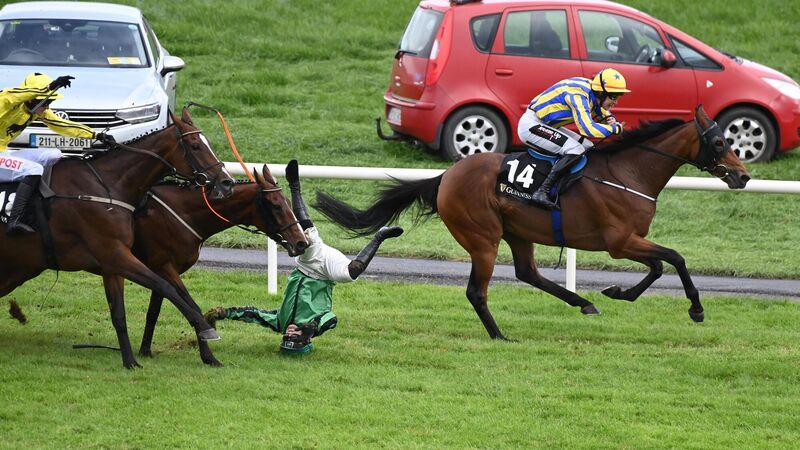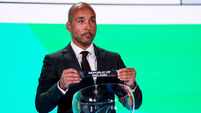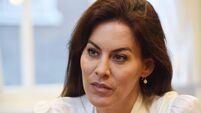Ruby Walsh: Kerry National a reminder that pro sport is about winning. Second is nowhere

Ups and downs: Busselton & J.J.Slevin (stripes) jump the last to win the Guinness Kerry National as Hewick & Jordan Gainford (green) part company, all were OK after their fall. Pic: HEALY RACING
Listowel buzzed on Wednesday afternoon and as Hewick surged to the front on the approach to last in the Kerry National, the place was rocking.
I know more than most that 'could', 'would', and 'should' mean you didn’t, and when he hurdled the last fence, barely getting half the required height to clear the jump, they were the only words anyone spoke on the island.
He ‘would’ have won if he didn’t all but fall, giving Jordon Gainford no chance of staying with him. He ‘could’ have gotten a foot higher because he had done so 15 times already in the race and ‘should’ have been able to alter his stride more than he did.
But he didn’t, and Busselton won. That’s sport, and part of the beauty that makes all sports so compelling: The emotional rollercoaster of highs and lows, and the margins between winners and losers being so tiny and uncontrollable.
JJ Slevin drove Busselton to the last fence, believing he had to fly it if he had any chance of winning. Hewick had just headed him, but a fast jump might keep him in the game, and he didn’t back off. Jordan Gainford knew he had the momentum to win, but the split-second calculations told him he, too, needed to be quick from A to B at the last.
Neither could afford to miss, but both met the fence on the wrong stride, too long to ask for a brave jump, but in too much of a battle to slow down and adjust. The one who did would lose.
Both horses, at full speed, would need to take a short stride without slowing down and then get the required height to clear the middle of the jump. Both were going to brush it, but both riders rolled the diced and went for it with aggression, desire, hunger and a will to win without the fear of losing.
JJ hit the jackpot, and Jordan hit the deck, but neither was in control of the situation. Reactions, instinct and adrenalin had taken over. Controlling it would have seen one or both slow down, but that’s riding not to lose, and the most competitive people can’t cope when they lose that way.
Some might call that reckless, but fortune favours the brave, and as disappointed as Jordan Gainford was leaving Listowel on Wednesday, losing having been safe would have hurt him more. He left wondering what he could have done differently, but had he controlled his adrenalin he would have left Listowel knowing what he did wrong.
Controlling the uncontrollable has a price, but trusting it pays more often than people think because professional sport is about winning. Second is nowhere.
For about three hours, horse racing was before the public accounts committee in the Oireachtas on Thursday morning. I am not going to admit that I sat and watched it all live, but I did scroll through to see what issues the spending of our government funding would raise.
The fact that both racing bodies operate under initials — HRI and the IHRB — seemed to confuse a few of those asking the questions, and both having new CEOs brought even more confusion. The extra funding the Curragh racecourse required was one issue, and HRI seemed to stumble over the price of land per acre that Tipperary racecourse bought.
The issue nobody seemed to want to answer was the package the former IHRB CEO got when he departed. It sounded like we might find out the details of that package in the next financial year’s accounts.
Still, the new IHRB CEO was a fresh face, and his debut public performance would attract racing eyes. The IHRB seems to have lost more battles than it has won in recent years, and a few loyal, front-line allies have departed along the way.
Darragh O’Loughlin seemed totally in control here and, with direct, informed answers, the regulator looks to have a confident person taking the wheel of its rocking ship. Next up for him will be the appointment of two senior figures, one as senior stipendiary steward and the other as race day operations manager. Who he chooses will determine his ship’s path and ultimately define his tenure.
Finally, Sean Levey got a raw deal when he failed a saliva test for amphetamines before racing at Sandown, which turned out to be a false positive. It took seven days for his urine sample results to be returned, which is more than enough time for the world to find the innocent guilty. But does it mean saliva testing should be stopped or used differently?
I am for them but only as an indicator for further testing. Those who fail a saliva test should be required to provide a urine sample, as they are, just like anyone selected randomly for drug testing. The urine sample should be the determining factor in any bans with the saliva test only to be used as a warning light.
Saliva tests are cheaper and allow testers to sample a more significant portion of riders. One from every race should be tested, making testing a daily possibility for riders. The current urine testing system takes at least a week to return a result, so plenty have ridden in the past knowing a positive finding was coming. But, with urine testing only being on random days, the scope for being caught is too broad.
False positives are too harmful for a rider’s reputation, and what happened to Sean can’t be repeated. Still, the fight against drug use must continue, so use them daily as a deterrent, question those with positive saliva tests, take a statement from those pressing their innocence and proceed as usual until the urine test has been analysed.
“I am not guilty, your honour,” probably springs to mind, but results that don’t match a rider’s initial statement from the positive salvia test should be considered a second offence and carry the appropriate suspension.








